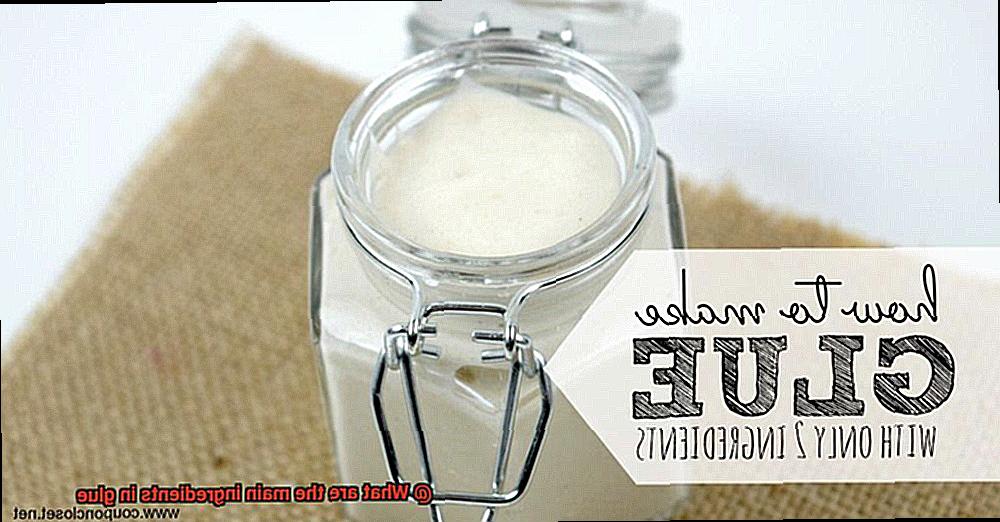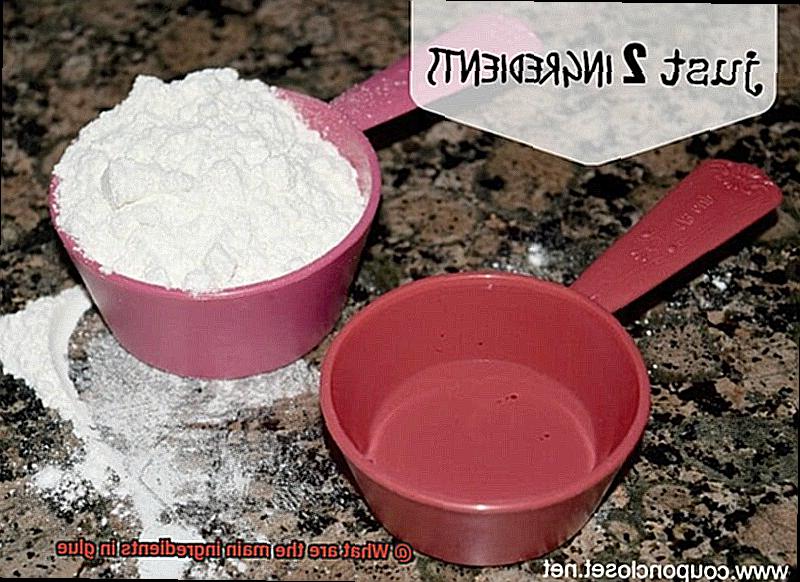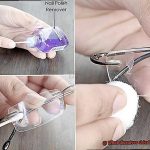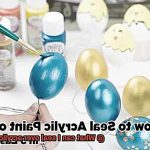Have you ever stopped to ponder what makes glue so incredibly sticky and adept at holding things together? Whether you’re fixing a shattered vase, unleashing your creativity with arts and crafts, or just sealing an envelope, glue is an absolute lifesaver.
But have you ever wondered about the secret sauce that gives it its magical bonding abilities? Well, look no further because in this blog post, we’re going to dive headfirst into the captivating world of glue and uncover its main ingredients.
So, get ready to embark on this adhesive adventure as we explore the main ingredients in glue.
What is Glue?
Contents

Glue, the unsung hero of our daily lives, has the remarkable ability to hold our world together. Whether it’s assembling a model airplane, fixing a broken vase, or creating a masterpiece artwork, glue is the magical substance that brings materials together in harmony. But what exactly is glue made of, and how does it work its adhesive wonders? In this captivating exploration, we will dive into the intricate world of glue, uncovering its core ingredients, various types, and wide-ranging applications.
The Core Ingredients: Building Blocks of Stickiness
At the heart of every glue formulation lie three key ingredients: polymers, solvents, and additives. These components work in tandem to create the adhesive properties that make glue so indispensable.
- a. Polymers: Glue owes its stickiness to these mighty molecules that form long chains, intertwining with surfaces and creating a strong bond. Common polymers found in glue include polyvinyl acetate (PVA), cyanoacrylate, and epoxy.
- b. Solvents: To make glue more user-friendly, solvents are added to dissolve the polymers and facilitate easy application. As the glue dries, these solvents evaporate, leaving behind a solid adhesive bond. Water, acetone, and toluene are popular solvents used in glue manufacturing.
- c. Additives: To fine-tune glue’s performance, various additives are incorporated into its composition. Thickeners adjust viscosity for better control during application, preservatives extend shelf life, fillers enhance strength or flexibility, and colorants add aesthetic appeal.
Types of Glue: Tailored for Every Purpose
Glue comes in a myriad of formulations tailored to specific applications and materials.
- Wood Glue: Crafted with resins derived from plants or animals, wood glue ensures a rock-solid bond with wooden surfaces. It withstands the stresses of woodworking projects, guaranteeing durability and longevity.
- Super Glue: Powered by cyanoacrylate, super glue is the superhero of adhesives. It forms an instant and unyielding bond, making it ideal for quick fixes and bonding various materials with precision.
- Craft Glue: The trusty companion of artists and crafters, craft glue is often water-based and features PVA polymers. Its easy application, versatility, and effortless cleanup make it a go-to adhesive for art projects, collages, and DIY endeavors.
Applications: The Boundless World of Glue
Glue’s versatility knows no bounds, finding its place in an array of industries and applications.
- Arts and Crafts: From kindergarten classrooms to professional studios, glue is an essential tool for creating collages, paper crafts, and intricate masterpieces.
- Woodworking: Wood glue holds the key to sturdy furniture, cabinets, and structures. It ensures seamless joints and reinforces the strength of wooden pieces.
- Construction: In the realm of construction, glue plays a pivotal role in bonding materials like metal, glass, or plastic. It strengthens structures, increases load-bearing capacity, and reduces the dependency on traditional mechanical fasteners.
- Automotive: Behind the sleek exteriors of cars lies the invisible hand of glue. It bonds parts together during manufacturing processes, ensuring structural integrity and enhancing safety.
The Main Ingredients in Glue
Glue may seem like a simple substance, but its ability to stick surfaces together is nothing short of magical. Have you ever wondered what makes glue so sticky and reliable? In this article, we’ll take a closer look at the main ingredients that make up glue and how they work together to create strong and long-lasting bonds.

The Power of Polymers:
At the heart of every glue formulation lies polymers, which are long chains of molecules with adhesive properties. These superheroes act as the backbone of the glue, binding all the other ingredients together and providing the stickiness we rely on.
Water: The Universal Solvent:
Water is another key ingredient found in many types of glue. Acting as a solvent, water helps dissolve other components and makes the glue easier to spread and work with. Water-based glues are particularly popular due to their non-toxic nature and ease of cleanup, making them perfect for arts and crafts projects.
Solvents: Dissolving Barriers:
Some glues use solvents other than water to dissolve polymers and other ingredients. These solvents enhance the glue’s consistency and make it easier to apply. However, it’s important to note that certain solvents can emit harmful fumes or be toxic, so proper ventilation is crucial when using these types of glues.
Fillers and Additives: Enhancing Performance:
To improve the consistency and performance of glue, fillers and additives are often incorporated into the formulation. Fillers such as calcium carbonate or silica help thicken the glue, ensuring it stays in place during application. Additives can also enhance specific properties like flexibility or resistance to moisture, tailoring the glue for different applications.
Preservatives and Stabilizers: Extending Shelf Life:
To prevent mold or bacterial growth and maintain the glue’s shelf life, preservatives and stabilizers are added. These ingredients ensure that your glue is ready to use whenever you need it, without any worries about spoilage or degradation.
Colorants: Adding a Splash of Personality:
In some cases, glues may contain colorants to give them a distinct appearance. While this may not affect their adhesive properties, colorful glues can add a fun touch to crafts and projects.
Polymers Used in Glue
Polymers are the unsung heroes of glue, providing the backbone and unique properties that make it all possible. These large molecules play a crucial role in the adhesive industry, allowing for strong and long-lasting bonds between different materials. Let’s delve deeper into the world of polymers used in glue, exploring their specific characteristics and applications.
One commonly encountered polymer in glue is polyvinyl acetate (PVA). PVA glue is a versatile adhesive that finds extensive use in woodworking and crafts. Its remarkable adhesion properties allow it to bond various materials together, while its ability to dry to a clear finish ensures a seamless and professional-looking outcome. Moreover, PVA glue is water-based, making it easy to clean up and non-toxic—a perfect choice for both professionals and hobbyists alike.
Another widely recognized polymer used in glue is cyanoacrylate, more commonly known as super glue. This fast-acting adhesive lives up to its name by bonding quickly and strongly, making it ideal for instant repairs or securing small objects. Whether you’re mending a broken ornament or assembling intricate models, super glue guarantees a durable and steadfast connection within seconds.
For applications requiring exceptional strength and resistance to heat and chemicals, epoxy resin comes to the forefront. Epoxy glues are formulated with epoxy polymers, renowned for their robust bonding properties and ability to withstand rigorous industrial environments. From construction projects to automotive repairs, epoxy glues ensure reliability and durability in even the most demanding situations.
When flexibility or extreme conditions come into play, silicone-based polymers rise to the occasion. Silicone adhesives provide excellent flexibility while simultaneously exhibiting remarkable resistance to high temperatures. So, whether you’re working on materials that need room to stretch or enduring extreme heat, silicone-based glue ensures a reliable bond that won’t let you down.
Acrylic polymers also have a significant presence in the world of glues. These versatile adhesives offer good bonding strength and find application in various forms, including liquid adhesives, tapes, and hot melt adhesives. Regardless of your specific needs, acrylic polymers can be relied upon to provide the necessary bond for a multitude of materials and applications.
In addition to these synthetic polymers, some glues even incorporate natural polymers like casein or animal hide glue. These traditional adhesives have been used for centuries and continue to be employed in specialty applications. Whether you’re feeling nostalgic or seeking something unique, exploring the world of natural glues can open up a whole new realm of possibilities.
Solvents Used in Glue
Glue, a remarkable invention that revolutionized the way we bond materials together, holds a mesmerizing secret. Have you ever pondered over what gives glue its remarkable stickiness and strength? The answer lies in the solvents used in its formulation. In this article, we will delve into the captivating world of solvents and explore their profound impact on adhesive properties.
Water: The Unstoppable Force of Emulsion Glue:
Water, one of the most frequently employed solvents in glue, takes center stage in water-based glues, also known as emulsion or latex glues. These versatile glues find their place in both household and industrial settings. Comprising a blend of water, polymers, and additives, water acts as a solvent by dissolving polymer particles, allowing them to effortlessly flow together. As the water evaporates during the drying process, the polymer particles form an unyielding bond, resulting in an adhesive that is undeniably strong.
Organic Solvents: The Speedy Allies of Bonding:
Derived from petroleum or natural gas, organic solvents stand as another vital category of solvents used in glue. These solvents can be further divided into volatile organic compounds (VOCs) and non-volatile organic compounds (NVOCs). VOC-based solvents like acetone, toluene, and ethyl acetate are commonplace in superglue or cyanoacrylate adhesives.
Their rapid dissolving capabilities bring about swift bonding by accelerating the curing process upon contact with moisture. Nevertheless, it is crucial to be cautious as they possess high flammability and emit potent odors that render them unsuitable for certain applications.
NVOC-based solvents like naphtha or mineral spirits, often found in contact adhesives or solvent-based glues, offer a longer working time before the adhesive sets, owing to their slower evaporation rate. These solvents boast lower volatility and emit milder odors compared to their VOC counterparts.
Alcohols and Esters: Versatile Partners in Glue:
Apart from water and organic solvents, glues harness alcohols and esters as solvents. Ethanol or isopropyl alcohol, frequently utilized in adhesives requiring rapid drying and low toxicity, represent alcohols that play pivotal roles. Esters, such as ethyl acetate or butyl acetate, find their niche in wood glues or construction adhesives due to their exceptional bonding abilities with porous surfaces.
Additives Used in Glue
Glue. It’s the magical substance that holds our world together. But have you ever wondered what makes glue so effective? Well, my friend, the secret lies in the additives. These little ingredients are the unsung heroes that enhance the properties and performance of glue. Let’s dive into the fascinating world of additives used in glue and discover how they work their magic.
First up, we have the plasticizers. These nifty additives increase the flexibility and elongation of glue. So when you’re fixing a broken toy or mending a torn shoe, it’s the plasticizer that keeps it all together, allowing for movement and deformation without losing its grip.
But that’s not all. Glue also needs to have the perfect consistency for easy application. Enter the thickening agents. These magical ingredients control the viscosity or thickness of the glue, ensuring it spreads evenly and smoothly. No more globs ruining your craft projects.
Now, let’s talk about volume. Some glues contain fillers that increase their volume without compromising their adhesive properties. Not only do fillers help reduce costs, but they also improve the overall performance of the glue, giving it that extra oomph.
But wait, there’s more. For glues exposed to sunlight or UV radiation, UV stabilizers come to the rescue. These additives prevent degradation caused by UV exposure, making sure your glued items stay intact over time.
It’s important to note that not all glues contain additives, and their types and amounts can vary depending on the specific glue and its intended use. Manufacturers must also ensure compliance with regulations and standards when using additives.
Fillers and Thickeners in Glue
Glue, the unsung hero of adhesion, owes its sticking power not only to its primary adhesive components but also to the secret ingredients mixed in. Fillers and thickeners, the dynamic duo of glue formulation, play a vital role in enhancing its adhesive properties and making it more versatile for various applications.
Fillers, like calcium carbonate and silica, are the glue’s thickening agents. Calcium carbonate not only thickens the glue but also reduces production costs by allowing smaller amounts of primary adhesive components to be used. Silica, on the other hand, improves the thixotropic properties of glue. Thixotropy, a fancy term for a substance becoming less viscous when agitated or sheared but returning to higher viscosity at rest, helps the glue flow smoothly during application and ensures a robust bond once it sets.
While fillers make glue thicker, thickeners add viscosity without altering its adhesive properties. Cellulose derivatives such as methylcellulose or hydroxyethylcellulose are popular thickeners derived from natural cellulose sources. These derivatives create a gel-like consistency in the glue, allowing it to adhere better to surfaces and preventing dripping or running. Polyvinyl alcohol (PVA), another common thickener, not only increases viscosity but also enhances adhesive strength when dried.
But wait, there’s more. Some glues go the extra mile by including additional additives. Plasticizers improve flexibility and elongation of the adhesive film while anti-foaming agents prevent unwanted bubbles during application. These carefully selected ingredients further enhance the performance of glue to meet specific requirements.
Preservatives and Colorants in Glue
Glue is not just a sticky substance; it relies on a combination of ingredients, including preservatives and colorants, to achieve its adhesive powers and maintain its quality. Preservatives act as the glue’s bodyguards, shielding it from harmful bacteria and mold that can deteriorate its effectiveness over time. One widely used preservative is methylisothiazolinone (MIT), which effectively inhibits the growth of bacteria and fungi. MIT is particularly suited for water-based glues due to its easy solubility and compatibility with other ingredients. Nevertheless, some individuals may have sensitivities or allergies to certain preservatives, prompting manufacturers to explore alternative options to reduce potential risks.
On the other hand, colorants are responsible for enhancing the visual appeal of glue. They give glue a specific color or appearance, making it more attractive to users. You might wonder why the color of glue matters if its primary purpose is just to stick things together. Well, in certain industries like crafting or construction, color-coding or identification is crucial. Additionally, adding a splash of color to adhesive products can simply bring joy to users.
The choice of colorant depends on the desired hue and intensity of the final product. Glue can be colored using synthetic dyes or natural pigments derived from plants, minerals, or even insects. For instance, titanium dioxide is a popular white pigment used in glue to achieve a clean appearance, while carbon black adds depth and darkness. Moreover, synthetic dyes offer endless possibilities for creating a rainbow of colors in glue.
It is important to note that while colorants enhance the aesthetics of glue, they do not impact its adhesive properties. Regardless of its color or visual appeal, glue will continue to fulfill its primary function of sticking things together.
Different Types of Glues and Their Ingredients
Today, we embark on a captivating journey into the world of glues and their ingredients. Whether it’s wood glue, super glue, or fabric glue, each type boasts its own unique blend of ingredients, perfectly suited for diverse projects. Let’s delve into the intriguing realm of glues.
Wood Glue: The Carpenter’s Magic Potion
Wood glue possesses an enchanting quality for carpenters and builders alike. Its secret ingredient is polyvinyl acetate (PVA), a mesmerizing substance that conjures a robust bond between wooden surfaces. However, this magical potion requires water to achieve its full potential, allowing for easy application and proper drying. So, when constructing a birdhouse or mending a broken chair, trust in the power of wood glue.
Super Glue: The Speedy Savior
In moments requiring instant bonding, super glue emerges as the unsung hero. Its secret lies in cyanoacrylate, a compound that reacts with air moisture to forge an unyielding bond. This adhesive marvel works with such incredible speed that caution must be exercised to avoid any unintended sticky situations – it truly lives up to its name.
Epoxy Glue: Unyielding Strength
When confronted with an arduous task demanding durability, epoxy glue is your steadfast companion. Comprised of two indispensable components – resin and hardener – this adhesive duo initiates a chemical reaction, birthing an indomitable bond. Impervious to heat, chemicals, and water, epoxy glue dons the mantle of a true superhero for demanding jobs.
Fabric Glue: Stitch-Free Seamstress
Calling all fashionistas and crafters. Fabric glue emerges as your salvation when seeking to unite fabric pieces without the need for a needle and thread. Its composition often consists of synthetic polymers like polyvinyl acetate or acrylic resins. Not only does it foster a flexible bond, but it also boasts the ability to withstand washing, allowing your unique designs to flourish.
Craft Glue: The Versatile Maestro
Craft glue reigns supreme as the jack of all trades in the adhesive realm. It effortlessly adheres paper, cardboard, foam, and even plastics. Craft glues can be water-based or solvent-based, depending on the project at hand. These adhesive superheroes rush to the rescue, ensuring success in all your arts and crafts endeavors.
71IzSTV_S20″ >
Conclusion
In conclusion, the main ingredients in glue are typically a combination of polymers, solvents, and additives.
These components work together to create a strong adhesive bond that can be used for various applications. Polymers, such as polyvinyl acetate (PVA) or cyanoacrylate, provide the adhesive properties by forming long chains that interlock with the surfaces being glued.
Additives, such as fillers or stabilizers, may also be included to enhance specific characteristics of the glue, such as flexibility or resistance to moisture.






